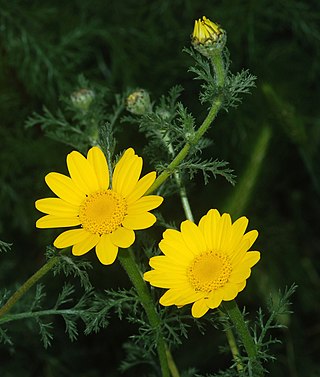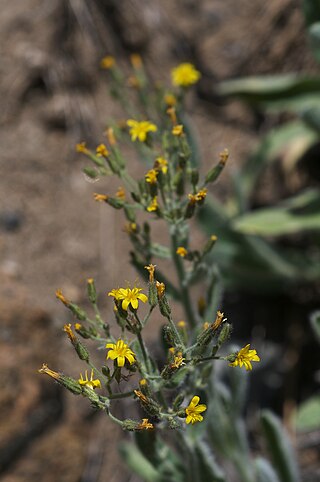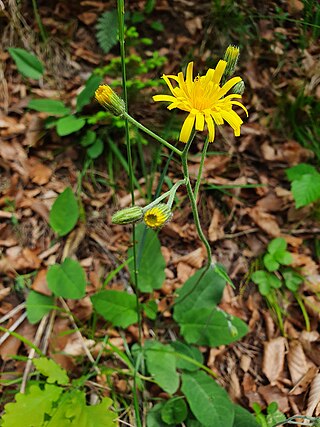| Hieracium laevigatum | |
|---|---|
 | |
| Scientific classification | |
| Kingdom: | Plantae |
| Clade: | Tracheophytes |
| Clade: | Angiosperms |
| Clade: | Eudicots |
| Clade: | Asterids |
| Order: | Asterales |
| Family: | Asteraceae |
| Genus: | Hieracium |
| Species: | H. laevigatum |
| Binomial name | |
| Hieracium laevigatum Willd. 1803 | |
| Synonyms [1] | |
Synonymy
| |
Hieracium laevigatum, or smooth hawkweed, is a Eurasian plant species in the tribe Cichorieae within the family Asteraceae. It is widespread across much of Europe and western Asia. [2] It is very similar to Hieracium sabaudum and can be found on dry, more or less nutrient rich soil in light woods, grassy embankments and fields, or on walls. [3]
Hieracium laevigatum is an herb up to 60 cm (2 feet) tall, with leaves on the stem rather than in a rosette at the bottom. Leaves are lance-shaped, up to 10 cm (4 inches) long, with large teeth along the edge. One stalk branches toward the top, producing numerous flower heads. Each head has several ray flowers but no disc flowers. [4]
- Subspecies [1]
- Hieracium laevigatum subsp. achalzichiense(Üksip) Greuter
- Hieracium laevigatum subsp. acrifolium(Dahlst.) Zahn
- Hieracium laevigatum subsp. analogum(Boreau) Zahn
- Hieracium laevigatum subsp. auriglandulum(Wiinst.) Zahn
- Hieracium laevigatum subsp. boreanum(Boreau) Zahn
- Hieracium laevigatum subsp. calothyrsum(Murr) Dalla Torre & Sarnth.
- Hieracium laevigatum subsp. chaubardianum(Arv.-Touv.) Zahn
- Hieracium laevigatum subsp. coronopifolioidesZahn
- Hieracium laevigatum subsp. dechyiKoslovsky & Zahn
- Hieracium laevigatum subsp. deltophylloidesZahn
- Hieracium laevigatum subsp. deseglisei(Boreau) Zahn
- Hieracium laevigatum subsp. dryadeum(Boreau) Zahn
- Hieracium laevigatum subsp. echinodermumZahn
- Hieracium laevigatum subsp. fagineum(Arv.-Touv.) Zahn
- Hieracium laevigatum subsp. ficifolium(Arv.-Touv.) Zahn
- Hieracium laevigatum subsp. flocciparumSchelk. & Zahn
- Hieracium laevigatum subsp. glareosum(Lönnr.) Greuter
- Hieracium laevigatum subsp. gorienseKoslovsky & Zahn
- Hieracium laevigatum subsp. gothiciforme(Dahlst.) Zahn
- Hieracium laevigatum subsp. gothicum(Fr.) Čelak.
- Hieracium laevigatum subsp. grandidensZahn
- Hieracium laevigatum subsp. hypopityforme(Üksip) Greuter
- Hieracium laevigatum subsp. knafii(Čelak.) Zahn
- Hieracium laevigatum subsp. laevigansZahn
- Hieracium laevigatum subsp. leucothyrsum(Litv. & Zahn) Greuter
- Hieracium laevigatum subsp. lineatum(Dahlst.) Zahn
- Hieracium laevigatum subsp. macrolygodesZahn
- Hieracium laevigatum subsp. magistri(Godr.) Zahn
- Hieracium laevigatum subsp. nivale(Froel.) Zahn
- Hieracium laevigatum subsp. perangustum(Dahlst.) Zahn
- Hieracium laevigatum subsp. pesianum(Arv.-Touv. & Belli) Zahn
- Hieracium laevigatum subsp. pictaviense(Sauzé & Maillard) Zahn
- Hieracium laevigatum subsp. pseudogothicum(Arv.-Touv.) Zahn
- Hieracium laevigatum subsp. retardatumZahn
- Hieracium laevigatum subsp. revolii(Sudre) Zahn
- Hieracium laevigatum subsp. rigidum(Hartm.) Čelak.
- Hieracium laevigatum subsp. sagotii(Boreau) Zahn
- Hieracium laevigatum subsp. semiglobosum(Dahlst.) Zahn
- Hieracium laevigatum subsp. stricticaule(Boreau) Zahn
- Hieracium laevigatum subsp. subgracilipesZahn
- Hieracium laevigatum subsp. tridentaticeps(Zahn) Zahn
- Hieracium laevigatum subsp. tridentatum(Fr.) Čelak.
- Hieracium laevigatum subsp. vendeanum(Boreau) Zahn
- Hieracium laevigatum subsp. vogesicolaZahn












